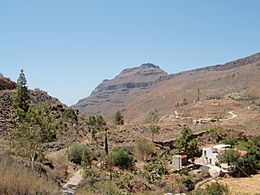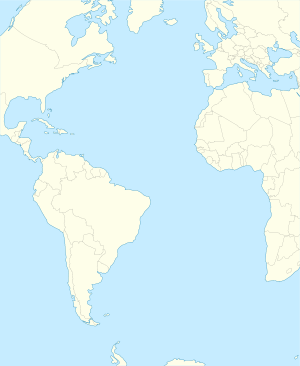Pilancones facts for kids
Quick facts for kids Pilancones Natural Park |
|
|---|---|
|
IUCN Category V (Protected Landscape/Seascape)
|
|

Ayagaures's Canyon
|
|
| Location | Gran Canaria |
| Area | 14,317 acres (5,794 ha) |
| Established | 1987 |
Pilancones Natural Park is a special protected area on the island of Gran Canaria, Spain. It is located in the San Bartolomé de Tirajana area. This park covers a large space of about 5,794 hectares (that's over 14,300 acres!).
Pilancones Natural Park is very important for protecting the soil. It also helps to refill underground water sources called aquifers. Many beautiful ravines, which are like deep valleys, run through the park. These ravines are interesting because of their unique shapes and stunning views.
The park is home to amazing pine forests on its hilltops. These forests are well-preserved and full of different kinds of birds. You can also find many types of cactus and spurge plants here. There are even small water areas that provide homes for aquatic animals. The park gets its name from natural pools called pilancones. These pools form when rainwater collects after a storm. Pilancones Natural Park protects many rare animals and plants. It also has features that are very interesting for scientists to study.
Why Pilancones is a Protected Park
This special area was first named Parque Natural de Ayagaures y Pilancones in 1987. Later, in 1994, it was officially classified as a natural park. This means it is a place where nature is protected.
Inside the park, there are open areas called montes that people can visit. These include "Ayagaures y Pilancones" and other public spaces like "La Plata, San Bartolomé y Maspalomas" and "Montaña del Rey". The park is also considered an ecologically sensitive area. This means it is very important for nature and needs extra care. It is also a special protection zone for birds, following rules from the European Union. This helps protect many bird species that live or visit the park.
The Ancient Pilancones Pine Tree
A very famous tree once stood in the park. It was called the Pino de Pilancones, which means Pilancones Pine Tree. This was a type of Pinus canariensis, a special pine tree found in the Canary Islands. Sadly, a big storm in 2008 destroyed this ancient tree.
The Pino de Pilancones was incredibly old, more than 500 years old! It also stood very tall, between 30 and 40 meters high. It was even considered one of the hundred most notable trees in all of Spain. Its end became unavoidable after large fires swept through the center of Gran Canaria in the summer of 2007.
Scientists who study tree rings, called dendrochronologists, examined a piece of this tree. They found that it was about 542 years old. This makes it the oldest known Canarian pine tree ever studied. By adding a few more years for the tree to grow to the height where the sample was taken, they figured out when it started growing. The Pino de Pilancones likely began its life around the winter of 1457-1458. This was at the very end of the medieval period, a long time ago!
See also
 In Spanish: Parque natural de Pilancones para niños
In Spanish: Parque natural de Pilancones para niños


